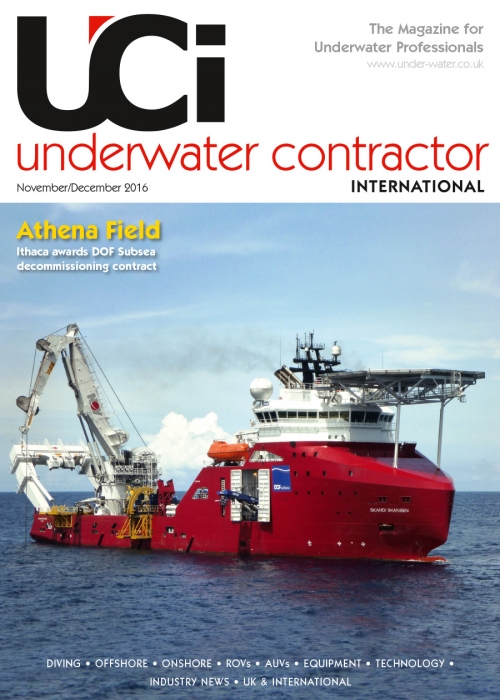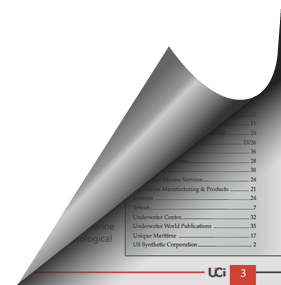
The Magazine for Underwater Professionals
![]() Mar/Apr 2016
Mar/Apr 2016
INDUSTRY NEWS - CONTRACTS & TENDERS
Petrobras contract for Fugro newbuild
Fugro of the Netherlands reports it has been awarded an inspection, repair and maintenance (IRM) contract by Petrobras in Brazil.
Under the contract, Fugro will deploy its new 83-metre ROV support vessel Fugro Aquarius for the IRM activities. The contract duration is one year with an option for an additional year.
Fugro Aquarius has been designed specifically for operations in the challenging conditions offshore Brazil. Capable of operating in water depths of 3000 metres, the vessel was built in Brazil and the local content exceeds 60%. Specialised equipment on board includes two 150HP Fugro FCV3000 work-class ROV systems.
Commenting on the award, Mathilde Scholtes, managing director of Fugro Brasil, said: “This contract reinforces Fugro’s market leadership in the IRM segment in Brazil and underlines the success of Fugro’s long-term relationship with Petrobras.”
OceanServer Technology, USA, reports it has received a contract for an Iver3-580 EP system from Canada Public Works and Government Services for delivery to the Defence Research and Development Canada (DRDC).
The Iver3 AUV will be used to augment existing autonomous systems and provide a platform to continue R&D development in underwater research at DRDC Atlantic.
“OceanServer has sold several systems to DRDC with a wide range of sonar, software and sensors for research into areas such as mine countermeasures,” said a spokesman. “DRDC will have access to Iver’s mature hardware and software interfaces to further studies in various adaptive behaviour ‘autonomy software’ architectures.”
He added: “The Iver’s primary system central processing unit (CPU) is capable of outputting vehicle position and trajectory information to a separate payload computer. The primary Iver3 CPU in return accepts input of autonomy decisions such as heading, speed and depth following OceanServer’s well-documented API for remote helm and other behaviour applications.”
Sweden-based MMT has announced the contract award for the OTEC (Ocean Thermal Energy Conversion) NEMO project in Martinique by DCNS, France.
The project is jointly developed by DCNS and its partners with the purpose to characterise the geophysical and geotechnical context of the area of an offshore power plant with a floating platform and a potential cable route to the town of Bellefontaine on the western coast of Martinique in the French Caribbean.
The floating platform is anchored in the sea and will use the temperature difference between the warm water at the surface and the cold water in the depths to produce non-intermittent and carbon-free electricity.
MMT said it was pleased to be part of the new development project and will conduct the survey with resources from the joint venture with Reach Subsea, Norway, including the DP2 vessel Stril Explorer, equipped with a work-class ROV that is mounted with a geophysical set up.
“This is an exciting project for us with interesting geology on volcano slopes in tropical waters. We look forward to a safe and fun operation with DCNS,” said Karin Gunnesson, MMT project manager.
Kraken Sonar, Canada, has announced its wholly-owned subsidiary Kraken Sonar Systems will supply its KATFISH towed sonar system to Israeli defence contractor Elbit Systems.
Elbit recently unveiled a state-of-the-art unmanned surface vehicle (USV) named Seagull. The Seagull USV is a multi-mission platform boasting high autonomy levels and modular features, allowing it to be rapidly reconfigured for a wide array of missions, including anti-submarine warfare and mine countermeasures.
“Elbit’s Seagull USV is one of the most advanced ocean drones in the world – one that will save lives,” said Karl Kenny, president of Kraken Sonar. “When our synthetic aperture sonar is integrated on Elbit’s Seagull USV, the system can provide remotely operated, unmanned, end-to-end mine hunting operations. These ocean drones can detect very small objects hidden on the seabed and enter confined spaces where underwater explosives are likely to be hidden. Since robotic systems can be remotely operated, their use can remove people from very dangerous missions – in essence, taking the sailor out of the minefield.”
The Seagull is a 40-foot (12-metre) autonomous launch that can be fitted with mission modules for anti-submarine warfare, mine countermeasures and force protection/patrol, including a stabilised, remotely operated .50-calibre machine gun and wire-guided torpedoes for stand-off destruction of naval mines and underwater improvised explosive devices. The system supports online operation in known and unknown areas, conducting area survey, search, detection, classification, identification, neutralisation and verification. It is also equipped to launch and recover other underwater robotic sensors to identify and neutralise mines.
Kraken’s KATFISH is an actively controlled, intelligent towfish platform used to generate real-time ultra-high-resolution seabed imagery and maps for a variety of military and commercial applications. The company’s miniature interferometric synthetic aperture sonar (MINSAS) technology delivers ultra-high seabed image resolution (three centimetres), simultaneously co-registered 3D bathymetry and superior area coverage rates. The ability to generate centimetre-scale sonar resolution in all three dimensions has the potential to provide significant improvements in the detection, classification and identification of small seabed objects such as underwater mines and IEDs, according to Kraken.
Italian oil and gas industry contractor Saipem has selected UK-based Tritech’s Gemini 620pd multibeam profiling system for its work-class remotely operated vehicles.
“Saipem has purchased a suite of Tritech products comprising Gemini 620pd sonars, surface control units (SCUs) and Gemini Hubs, for accurate time stamped data,” said Aberdeen-headquartered Tritech.
The Gemini 620pd sonars will run in a dual-head configuration, to provide a wide swathe of high-resolution bathymetry data, the company said.
Western Advance, the exclusive distributor for UK-based Applied Acoustic Engineering (AAE) in Australia, has completed a contract for the supply of one of AAE’s Nexus USBL systems to Neptune Marine Services, headquartered in Perth, Western Australia.
AAE said the provision of this system is notable as it marks the 450th USBL system that the company has supplied to the subsea industry, further demonstrating its strong position in this field.
Having been a regular user of the Nexus USBL through Western Advance’s rental facility, Neptune’s operations manager, Pat Fournier, said: “Given the amount of work we are now undertaking where the use of a USBL system is a requirement, it makes sense for Neptune to invest in a permanent system and as our operators have built up a good track record with the Nexus system, the decision to purchase wasn’t difficult.”
USA-based marine services company C-Innovation, a member of the Edison Chouest Offshore, USA, family of companies, has ordered four AUVs from Kongsberg Maritime, Norway. The order adds AUV capabilities to C-Innovation’s ROV fleet.
The two HUGIN vehicles under order are depth rated to 4500 metres, while the two MUNIN vehicles are rated to 1500 metres.
“All are equipped with the latest generation sonar, echo-sounders, cameras and profilers,” explained a spokesman for C-Innovation.
“All four are specially designed for subsea inspection, mapping and pipeline surveys. They feature the most advanced autonomous pipe-line tracking software, en-abling the AUV to track a pipe using SAS (synthetic aperture sonar) or sidescan, as well as flying overhead collecting bathymetry, photos and laser profiles,” he said.
The spokesman added that the HUGINs include swappable batteries and removable data storage, while the MUNINs have a fast-charge system and data download facility designed to maximise productivity and minimise downtime between dives.
The HUGINs are equipped with the latest generation of HISAS 1032 SAS, he said.


